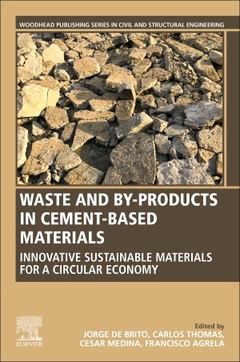Description
Waste and Byproducts in Cement-Based Materials
Innovative Sustainable Materials for a Circular Economy
Woodhead Publishing Series in Civil and Structural Engineering Series
Coordinators: de Brito Jorge, Thomas Carlos, Medina Cesar, Agrela Francisco
Language: English
Subjects for Waste and Byproducts in Cement-Based Materials:
808 p. · 15x22.8 cm · Paperback
Description
/li>Contents
/li>Readership
/li>Biography
/li>Comment
/li>
Waste and By-Products in Cement-Based Materials: Innovative Sustainable Materials for a Circular Economy covers various recycled materials, by-products and wastes that are suitable for the manufacture of materials within the spectrum of so-called cement-based materials (CBM). Sections cover wastes for replacement of aggregates in CBM, focus on the application of wastes for the replacement of clinker and mineral additions in the manufacture of binders, discuss the optimization process surrounding the manufacture of recycled concrete and mortars, multi-recycling, advanced radiological studies, optimization of self-compacting concrete, rheology properties, corrosion prevention, and more.
Final sections includes a review of real-scale applications that have been made in recent years of cement-based materials in roads, railway superstructures, buildings and civil works, among others, as well as a proposal of new regulations to promote the use of waste in the manufacture of CBM.
Section A Waste for aggregates in cement-based materials 1 Modeling the interfacial transition zone between recycled aggregates and industrial waste in cementitious matrix C. Medina, J. Sánchez, I.F. Sáez del Bosque, M. Frías, and M.I. Sánchez de Rojas 2 Waste for aggregates in ultrahigh performance concrete (UHPC) F. Lopez Gayarre, I. Lopez Boadella, J. Suarez Gonzalez, C. Lopez-Colina, M. Serrano Lopez, and Flavio Stochino 3 Use of coal bottom ash and other waste as fine aggregates in lightweight cement-based materials B. González-Fonteboa, F. Martínez-Abella, R. Rodríguez-Álvaro, E. Rey-Bouzón, S. Seara-Paz, and M.F. Herrador 4 Residual biomasses as aggregates applied in cement-based materials M. López-Alonso, M. Martín-Morales, M.J. Martínez-Echevarría, F. Agrela, and M. Zamorano 5 Technical and economic implications of using recycled fiber-reinforced polymer waste as aggregate in concrete Ardavan Yazdanbakhsh Section B Waste for binders and additions 6 Application of phosphogypsum for the improvement of eco-efficient cements J. Rosales, M. Gázquez, M. Cabrera, J.P. Bolivar, and F. Agrela 7 Effect of wastes as supplementary cementitious materials on the transport properties of concrete Yury Villagrán-Zaccardi, Natalia Alderete, Carlos Pico-Cortés, Claudio Zega, Puput Risdanareni, and Nele De Belie 8 Fly ash-incorporated recycled coarse aggregate-based concrete Sushree Sunayana and Sudhirkumar V. Barai 9 Industrial waste from biomass-fired electric power plants as alternative pozzolanic material I.F. Sáez del Bosque, M.I. Sánchez de Rojas, E. Asensio, M. Frías,and C. Medina 10 Inorganic binders from petrochemical industry waste: The case of fluid catalytic cracking catalyst residue M.V. Borrachero, J. Payé, J. Monzó, L. Soriano, and M.M. Tashima 11 Utilization of metallurgical wastes as raw materials for manufacturing alkali-activated cements A.T.M. Marsh, T. Yang, S. Adu-Amankwah, and S.A. Bernal Section C Optimization of concrete and mortar for a circular economy 12 Multirecycled concrete aggregates in concrete production Jorge de Brito, Luís Evangelista, and Carlos Thomas 13 Radiological shielding concrete using steel slags P. Tamayo, Carlos Thomas, J. Rico, Jesús Setién, Juan Antonio Polanco, S. Pérez, and S. Manñanes 14 Self-compacting concrete also standing for sustainable circular concrete Sandra Nunes and Carla Costa 15 Optimization of self-compacting recycled concrete manufactured with waste and byproducts Juan Manso (Manuel), Francisco Fiol, Carlos Thomas, Vanesa Ortega-López, Vi
Industrial manufacturers producing aggregates from waste; binder and additive producers in the cement and chemical industries; designers, builders and manufacturers; regulators, materials scientists and engineers and researchers involved in sustainable construction.
Lisbon. His main research topic is sustainable construction, particularly on the use of recycled aggregates in concrete and mortars. He has participated in 20 competitively financed research projects (four as the principal investigator) and supervised 20 PhD and 150 MSc theses. He is the author of 3 previous books, 20 book chapters, 250 journal and 450 conference papers. He is the editor-in-chief of the Journal of Building Engineering, an associate editor of the European Journal of Environmental and Civil Engineering, a member of the editorial boards of 15 other international journals and a member of the CIB, FIB, RILEM, IABMAS and IABSE organisations.
Carlos Thomas is an Associate Professor at the Materials Science and Engineering Laboratory in the Civil Engineering School of the University of Cantabria, Spain. He received his International PhD with cum Laude and Extraordinary Doctorate Award in 2013. His research activity has focused on the evaluation of construction, demolition and industry wastes for the manufacture of recycled mortars and concrete. In the last five years, he has participated as Principal Investigator in 5 R&D projects and as a researcher in another 10 R&D projects, with both public and private funding, related to recycled materials. He is the author of 20 JCR papers, one of them certified as one of the 25 most downloaded in ScienceDirect, and more than 80 congress communications and conferences. He has undertaken research stays in France, Germany, Brazil, and Portugal, and he is one of the promoters of the "Spanish Recycled Concrete Network".
César Medina is a reader of the Department of Construction of Civil Engineering, University of Extremadura, Spain. He earned his PhD. from the University of León in 2011. He has authored over 40 research articles in peer-reviewed j
- Favors the institution of the circular economy in the construction industry by eliminating the barriers that currently prevent industrial waste from being valorized by its inclusion in CBM design
- Features an in-depth exploration of the strengths and weaknesses of new raw materials and their application to CBMs
- Features real-scale applications that have been made in recent years of cement-based materials in roads, railway superstructures, buildings and civil works, among others
- Presents current, state-of-the-art, and future-prospects for the use of industrial waste in CBMs




